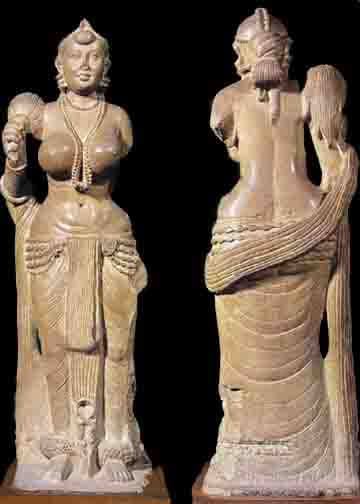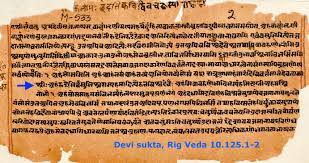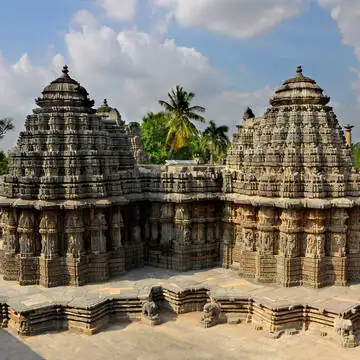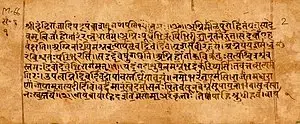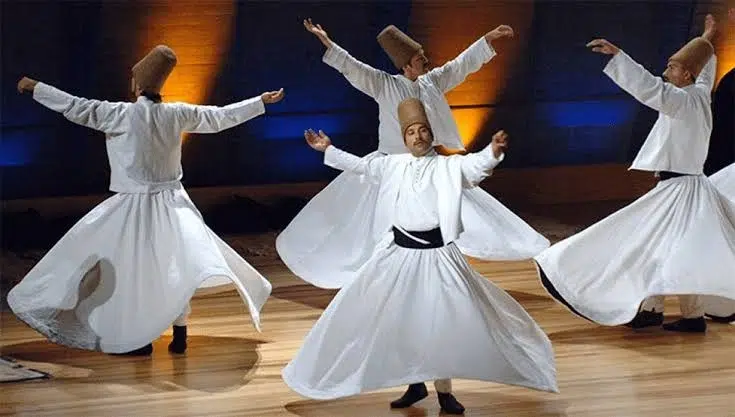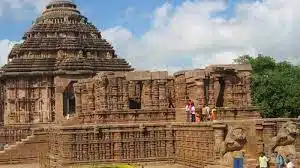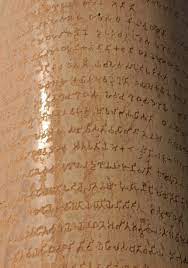Gandhara, Mathura And Amravati Schools
During the start of the Christian era, Buddhism expanded substantially and stimulated a renewed artistic passion to illustrate the message of Buddha and this led to the development of three main schools of sculpture in India which had evolved their own styles and distinctions. These were named as the Gandhara, Mathura, and Amaravati schools of art, after the places of their prominence.
Before Kanishka, Buddha was worshipped in the stupas in the form of symbols. Kanishka issued a golden coin where for the first time the figure of Buddha appears. After that, Kanishka sponsored the sculptors of Greco-Roman origin to create the image of Buddha.
Know about Kushan Empire and Kanishka
Gandhara School
The Gandhara School of art had developed in the first century AD along with Mathura School during the reign of the Kushana emperor Kanishka. Both Shakas and Kushanas were patrons of the Gandhara School, which is known for the first sculptural representations of the Buddha in human form. The art of the Gandhara school was primarily Mahayana and shows Greco-Roman influence.
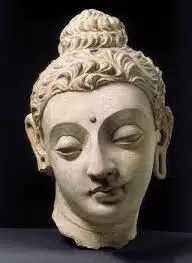
- The Gandhara school of Art developed in the western frontiers of Punjab, near modern-day Peshawar and Afghanistan.
- Gandhara School came to be known as the Greco-Indian School of Art.
- The Gandhara School flourished in two stages in the period from 50 B.C. to 500 A.D.
- The Gandhara School of art flourished during Kanishka’s reign.
- Gandhara School images were carved with finer details (Curly hair, anatomical accuracy, spatial depth, and foreshortening) etc.
- The reliefs of the Gandhara Sculpture depict Buddha s birth, his renunciation and his preaching and the best of the sculptures were produced during the first and second centuries A.D.
- The drapery was thick with large and bold fold lines also the human body was cast in a realistic manner with minute attention being given to physical features like a moustache, muscles, and curly hair.
- The Gandharan Buddha image was inspired by Hellenistic realism, influenced by Persian, Scythian, and Parthian models. In contrast with Mathura School, the Gandhara School images are known for their anatomical accuracy, spatial depth, and foreshortening. In this art, Buddha’s curls were altered into wavy hair. The head of the Buddha matched very much with Greek God Apollo.
- Various Mudras of Buddha in Gandhara School of art are:
- Abhaya Mudra – Don’t fear
- Bhumisparsha Mudra -Touching the earth
- Dhyana mudra – Meditation
- Dharmachakra Mudra – A preaching mudra
- The Bamyan Buddha of Afghanistan was an example of the Gandhara School. The other materials used were Mud, Lime, and Stucco. However, Marble was NOT used in Gandhara art. Terracotta was used rarely.
- Jalalabad, Hadda, Bamaran, Begram & Taxila were the main centres where art pieces of Gandhara School have been found.
Mathura School
Mathura School of Art also flourished mainly during the reign of the Kushana emperor Kanishka. The main traditional centre of production in this school was Mathura, and other important centres were Sarnath and Kosambi. The material used in this school was the spotted red sandstone. This art reached its peak during the Gupta period in the 6th or 7th century.
Difference Between Hinayana, Mahayana And Vajrayana Buddhism
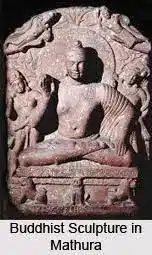
- The Mathura school images include those of Buddha, Bodhisattvas, Vishnu, Shiva, Yakshas, Yakshinis, Jinas etc. representing its vitality and assimilative character as a result of the religious zeal of Brahmanism, Jainism and Buddhism.
- The Hindu Gods were represented using their aayudhas.
- In Mathura style, the focus was laid on internal beauty and facial sentiments rather than bodily gestures.
- There is boldness in carving the large images as the first Mathura image creators never aimed to sculpt an anatomically correct human Buddha.
- Before the development of this school, Buddha was never depicted in a human form at any of Sanchi, Barhut or Gaya. Buddha was represented only as symbols, mainly two footprints or wheels. Artisans from Mathura initially continued to depict symbols but gradually the human image of Buddha appeared independent of other schools of art. This image of human Buddha was modelled on images of Yakshas rather.
- Yaksha images were found during the Mauryan period.
- Some of the masterpieces of Mathura school include Wema Kadphises and Kaniska, Parkham Yaksa, Maholi Bodhisattva and seated Kubera.
Comparison of Gandhara and Mathura Buddha
In the Gandhara school Buddha portrayed had Hellenistic features whereas in the Mathura school the Buddha was modelled on earlier Yaksha images. The Gandhara School also had Roman and Greek influences and assimilated Archimedean, Parthian and Bactrian. The Buddha has curly hair and there are linear strokes over the head. The forehead plane has protruding eyeballs, the eyes are half-closed and the face and cheeks are not round like the images found in other parts of India. The ears are elongated especially the earlobes.
However, there are certain drawbacks to the Gandhara school’s portrayal of the Buddha. The Buddha image of the Gandhara school has been claimed to be an original contribution but its aesthetic quality is indifferent and it lacks the vigour and independence of expression that characterise the free-standing Bodhisattvas of Mathura. The Indian elements derived from the ideal yogi type, namely the lotus seat and the meditative gaze could not be properly assimilated, and the schematic folded drapery, heavy ornamentation and very often the moustaches betray a taste lacking in refinement.
In the Mathura art, Buddha’s images have fleshy bodies and the shoulders are broad. The Sanghati (garment) covers only one shoulder. Buddha is accompanied by attendant figures like Padmapani and Valrapani Boddhisattvas. The Buddha image is accompanied by Halo around his head which is very large. With respect to the face of Buddha, it is round with fleshy cheeks.
- The Gandhara school of art flourished from the first century BC to fifth century AD whereas the Mathura school of art originated in the first century BC and flourished till the twelfth century AD.
- The Gandhara school of art mostly flourished in areas of Afghanistan and present North-west India whereas the Mathura school of art developed and flourished in Mathura and areas of Uttar Pradesh.
- Gandhara school of art was influenced by Buddhism while Mathura school of art was influenced by Hinduism, Buddhism and Jainism.
- Mathura Style was indigenously developed while Gandhara Style had a strong Greek influence and it was based on Greco-Roman Norms (known as Graeco-Buddhist School of Art).
- In Mathura School material used was Spotted Red Sandstone while in Gandhara School, Blue-grey Mica schist / Grey Sandstone was used.
- In Mathura School, during the Early period, the light volume having a fleshy body was carved. In later Periods flashiness got reduced and Buddha was carved out in various Mudras. While in Gandhara School images were carved with finer details (Curly hair, anatomical accuracy, spatial depth, and foreshortening) and Buddha was carved out in various Mudras.
- The expression of calmness is the centre point of attraction of Gandhara Buddha whereas Mathura Buddha is delighted in mood, seated in Padmasana and right hand in Abhaya mudra and left hand on left thigh showing masculinity.
- In Gandhara Style, the Halo is not decorated, in general, and the images are much more expressive while in Mathura Style the halo around the head of Buddha was heavily decorated and the images are less expressive.
In due course of time, it appears that the Mathura, and Gandhara arts were cross-fertilized, and the result of this synthesis refined and purified the Buddha image that appeared in the Gupta period.
Amravati School
The third type of sculpture art that Flourished during the Kushana time was at Amaravati and Nagarjunkonda in Andhra Pradesh.
- In the southern parts of India, the Amravati School developed on the banks of the Krishna River, under the patronage of the Satavahana rulers.
- Sculptural form in Amravati Art is characterised by intense emotions as the figures are slim, have a lot of movement, bodies are shown with three bents (i.e. tribhanga), and the sculptural anatomy is more complex than at Stupa of Sanchi.
- The white limestone of the sculptures creates the illusion of marble and is as fresh today as it was when it left the hands of the carvers. It is a sensuous art, reflecting the joys of the people who had adopted the way of the Buddha as the new path of freedom and not of estrangement from the world.
- Prominent places where this style developed are Amravati, Nagarjunikonda, Goli, Ghantasala and Vengi.
- Symbolic representation of Buddha’s life, the Buddha almost always being represented by a symbol, though in two or three places he is personified.
- Like the Sanchi Stupa, the Amaravati Stupa also has pradakshina patha enclosed within a vedika on which many narrative stories from the life of Buddha and bodhisattva dominate such episodes relating to the Birth, the miracles, and Enlightenment and the victory over Mara, Sundari, Nanda, Tushita heaven and Angulimala are depicted.
- Both religious and secular images were present in this style.
- Later, this style got transformed into Pallava and Chola architecture.
- Numerous scenes of dance and music adorn these reliefs, which are very tender in conception and bespeak an irrepressible joy of life.
- The sculptural remains of Amaravati have found their way to the British Museum and the Madras Museum. But the carvings of Nagarjunakonda are preserved almost in entirety at the site.
Important Differences Between Hinayana, Mahayana, And Vajrayana Buddhism
Difference between the Gandhara School, Mathura School and Amravati School
| School | Gandhara School | Mathura School | Amravati School |
| External influence | The heavy influence of Greek or Hellenistic sculpture, so it is known as Indo-Greek art. | It was developed indigenously. | It was developed indigenously. |
| Material used | Early Gandhara School used bluish-grey sandstone while the later period saw the use of mud and stucco. | The sculptures of Mathura School were made using spotted red sandstone. | The sculptures of Amravati School were made using white marble. |
| Religious Influence | Mainly Buddhist imagery, influenced by the Greco-Roman pantheon. | Influence of all three religions of the time, i.e. Hinduism, Jainism and Buddhism. | Mainly Buddhist influence. |
| Patronage | Kushana rulers | Kushana rulers | Satavahana rulers. |
| Area of development | Developed in the North-West Frontier, in the modern-day area of Kandahar. | Developed in and around Mathura, Sonkh and Kankalitila. Kankalitila was famous for Jain sculptures. | Developed in the Krishna-Godavari lower valley, in and around Amravati, Nagarjunakonda, Goli, Ghantasala and Vengi. |
| Features of Buddha sculpture | Spiritual Buddha Sad Buddha Bearded Buddha Less ornamentation Great detailing Buddha in Yogi postures Greek factors like wavy hair, a large forehead, and long ears. | Delighted Buddha Less spiritual Shaven head and face Muscularity Energetic The graceful posture of Buddha Seated in Padmasana | Symbolic representation of Buddha’s life Lives of Buddha in both human and animal forms. |
Also refer:

